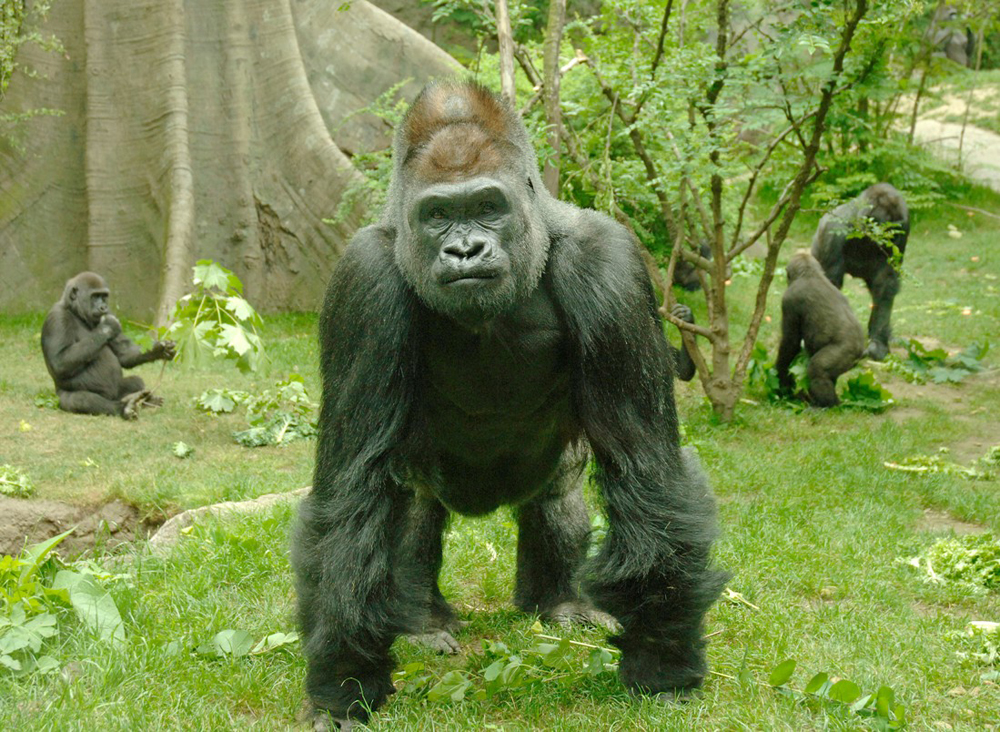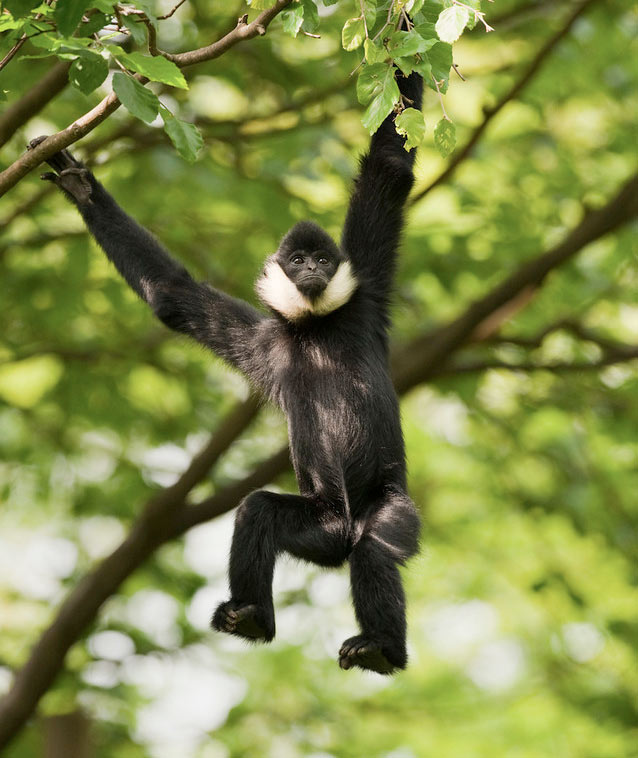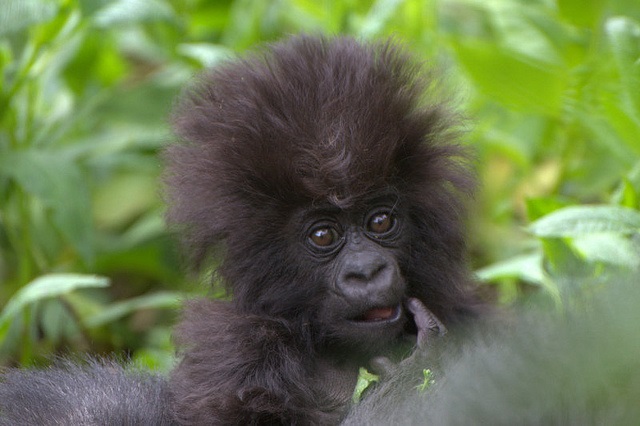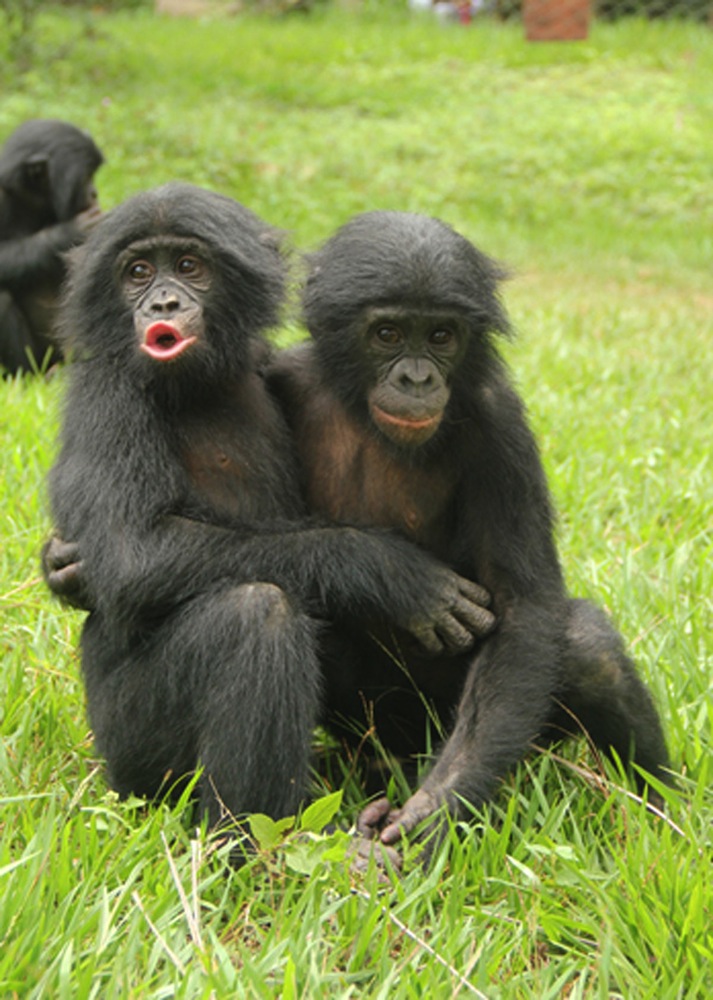Facts About Apes

Apes are humanity's closest living relatives. In fact, people are apes; humans share about 98 percent of their DNA with chimpanzees. The non-human types of apes are divided into two groups: great apes — gorillas, bonobos, chimpanzees and orangutans — and lesser apes — gibbons and siamangs.
Apes are not monkeys; they belong to different branches of the Simian infraorder, and there are several physical differences. Apes do not have tails, while most monkeys do, and apes are typically larger than monkeys, according to the Smithsonian National Zoological Park. Apes' noses are short and broad, while monkeys' noses are more snout-like. Apes also have larger brains than monkeys, and they are capable of using tools and learning language.

Size
Just like their classifications suggest, great apes are large, while lesser apes are small. Gorillas, the largest of the apes, typically are about 4.5 to 5.5 feet (1.37 to 1.67 meters) tall when upright and weigh 200 to 450 lbs. (91 to 204 kilograms), according to Defenders of Wildlife. Mountain gorillas, though, can grow to 6 feet tall and weigh 300 to 485 lbs. (135 to 220 kg).
Orangutans are the world's largest tree-dwelling animal. They grow to 4 to 4.5 feet (1.2 to 1.4 m) tall and weigh 90 to 200 lbs. (41 to 91 kg).
Gibbons and siamangs are much smaller than great apes. They typically weigh around 9 to 28 lbs. (3.9 to 12.7 kg). Siamangs grow to 29.5 to 35.5 inches (75 to 90 centimeters) tall from head to rump, according to the San Diego Zoo.
Habitat
The habitats of great apes and lesser apes are very limited. The great apes live in Africa and Asia, according to the National Zoo. They tend to live in jungles, mountainous areas and savannas.
Lesser apes live in Asia in evergreen tropical rainforests and monsoon forests. Siamangs prefer to live 80 to 100 feet (25 to 30 m) in the air in the trees found in Malaysia and Indonesia.

Habits
A group of apes is called a tribe or a shrewdness. All apes are very social. Gibbons, for example, live in small family groups of two to six individuals. Siamangs are so close that they almost never wander more than 30 feet (10 m) apart, according to the San Diego Zoo. Gorillas live in family groups that can include as many as 30 members. Chimpanzees are the most social of all the apes, and live in communities with 15 to 120 individuals.
During the day ape families eat, play and protect each other. At night they sleep in nests made from branches or foliage on the ground or in trees.
Gibbons are monogamous, which is very rare in the animal kingdom. In fact, only 3 percent of the animal kingdom practices monogamy, according to the Anthropological Institute of University Zürich-Irchel Winterthurerstrasse.
Diet
Apes are herbivores for the most part, but they also may eat small animals or bugs to supplement their diet. Gibbons, for example, eat mostly fruit, but they also munch on leaves, flowers and insects. Orangutans eat a fruit diet that is supplemented with vegetation, invertebrates, mineral-rich soil and small vertebrates. A chimp's diet is mainly fruits supplemented with insects, birds and small mammals, according to the Center for Great Apes.

Offspring
Apes have offspring much like humans. They have live births after a gestation period of around eight and a half to nine months and typically give birth to only one or two babies at a time. They also breastfeed their young for an extending amount of time, like humans.
Unlike other animals, apes take care of their young for many years. Apes also take much longer to mature than other animals. Some apes can take as long as 12 to 18 years to fully develop into an adult.
Classification/taxonomy
The taxonomy of apes (hominoids), according to the Integrated Taxonomic Information System (ITIS), is:
Kingdom: Animalia Subkingdom: Bilateria Infrakingdom: Deuterostomia Phylum: Chordata Subphylum: Vertebrata Infraphylum: Gnathostomata Superclass: Tetrapoda Class: Mammalia Subclass: Theria Infraclass: Eutheria Order: Primates Suborder: Haplorrhini Infraorder: Simiiformes Superfamily: Hominoidea
Family: Hominidae Subfamily: Homininae (gorillas, hominoids and chimps)
Genus: Gorilla
Species: Gorilla beringei (Eastern gorilla)
- Subspecies: Gorilla beringei beringei (Mountain gorilla), Gorilla beringei graueri (Grauer's gorilla)
- Subspecies: Gorilla gorilla diehli (Cross River gorilla), Gorilla gorilla gorilla (Western lowland gorilla)
Genus: Homo
- Species: Homo sapiens (Human)

Genus: Pan
- Species: Pan paniscus (bonobos, pygmy chimpanzee)
Species: Pan troglodytes (common chimpanzee)
- Subspecies: Pan troglodytes ellioti (Nigeria-Cameroon chimp), Pan troglodytes schweinfurthii (Eastern chimp), Pan troglodytes troglodytes (Central chimp), Pan troglodytes verus (Western chimp)
Subfamily: Ponginae (orangutans)
Genus: Pongo
- Species: Pongo abelii (Sumatran orangutan)
Species: Pongo pygmaeus (Bornean Orangutan)
- Subspecies: Pongo pygmaeus morio (Northeast Borneo orangutan), Pongo pygmaeus pygmaeus (Northwest Borneo orangutan), Pongo pygmaeus wurmbii (Central Borneo orangutan)
Family: Hylobatidae
Genus: Hoolock
Species: Hoolock hoolock (Western hoolock gibbon)
- Subspecies: Hoolock hoolock hoolock (Western hoolock gibbon), Hoolock hoolock mishmiensis (Mishmi Hills hoolock gibbon)
- Species: Hoolock leuconedys (Eastern hoolock gibbon)
Genus: Hylobates
- Species: Hylobates abbotti (Abbott's gray gibbon)
- Species: Hylobates agilis (agile gibbon)
- Species: Hylobates albibarbis (Bornean white-bearded gibbon)
- Species: Hylobates funereus (East Bornean gray gibbon)
- Species: Hylobates klossii (Kloss' gibbon)
Species: Hylobates lar (white-handed gibbon, Lar gibbon)
- Subspecies: Hylobates lar carpenteri (Carpenter's Lar gibbon), Hylobates lar entelloides (Central Lar gibbon), Hylobates lar lar (Malayan Lar gibbon), Hylobates lar vestitus (Sumatran Lar gibbon), Hylobates lar yunnanensis (Yunnan Lar gibbon)
Genus: Nomascus
- Species: Nomascus annamensis (Northern yellow-cheeked crested gibbon)
Species: Nomascus concolor (Western black crested gibbon, black crested gibbon)
- Subspecies: Nomascus concolor concolor (Tonkin black crested gibbon), Nomascus concolor lu (Laotian black crested gibbon)
Genus: Symphalangus
- Species: Symphalangus syndactylus (Siamang)
Conservation status
Many ape species are endangered according to the International Union for Conservation of Nature's Red List of Threatened Species. The Western gorilla, for example, is listed as critically endangered due to hunting and outbreaks of ebola. The chimpanzee and many types of gibbons are also endangered.
Bonobos apes live only in the Congo Basin rainforests of central Democratic Republic of the Congo, according to the World Wildlife Federation, with a population of only 29,500 to 50,000 individuals.
Other facts
According to the Smithsonian National Zoological Park, humans' and gorillas' bodies are so much alike, diseases can be transmitted from humans to gorillas and vice versa. As infants, gorillas are given the same as inoculations humans.
Gibbons are very good jumpers. They can leap around 30 feet (9 meters) at one time, according to the University of Michigan.
The lifespan of an ape is quite long. Chimps and other great apes can live up to 50 years in the wild.
Additional resources
Sign up for the Live Science daily newsletter now
Get the world’s most fascinating discoveries delivered straight to your inbox.











